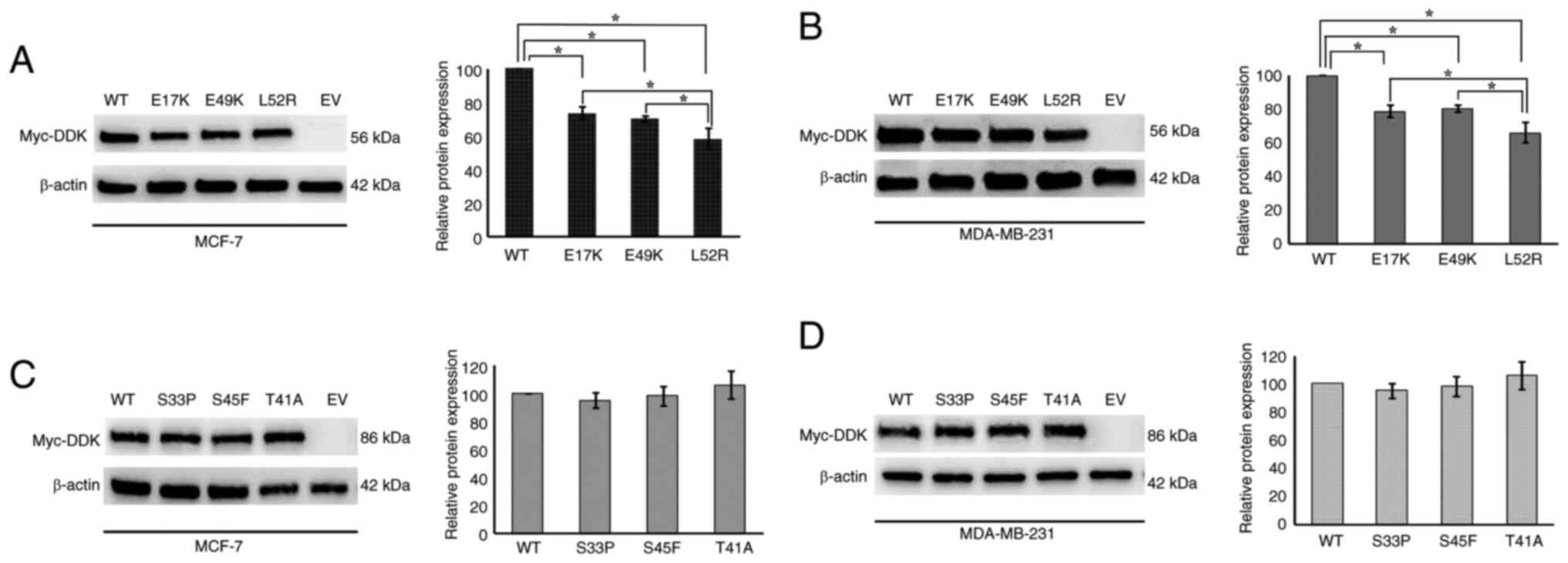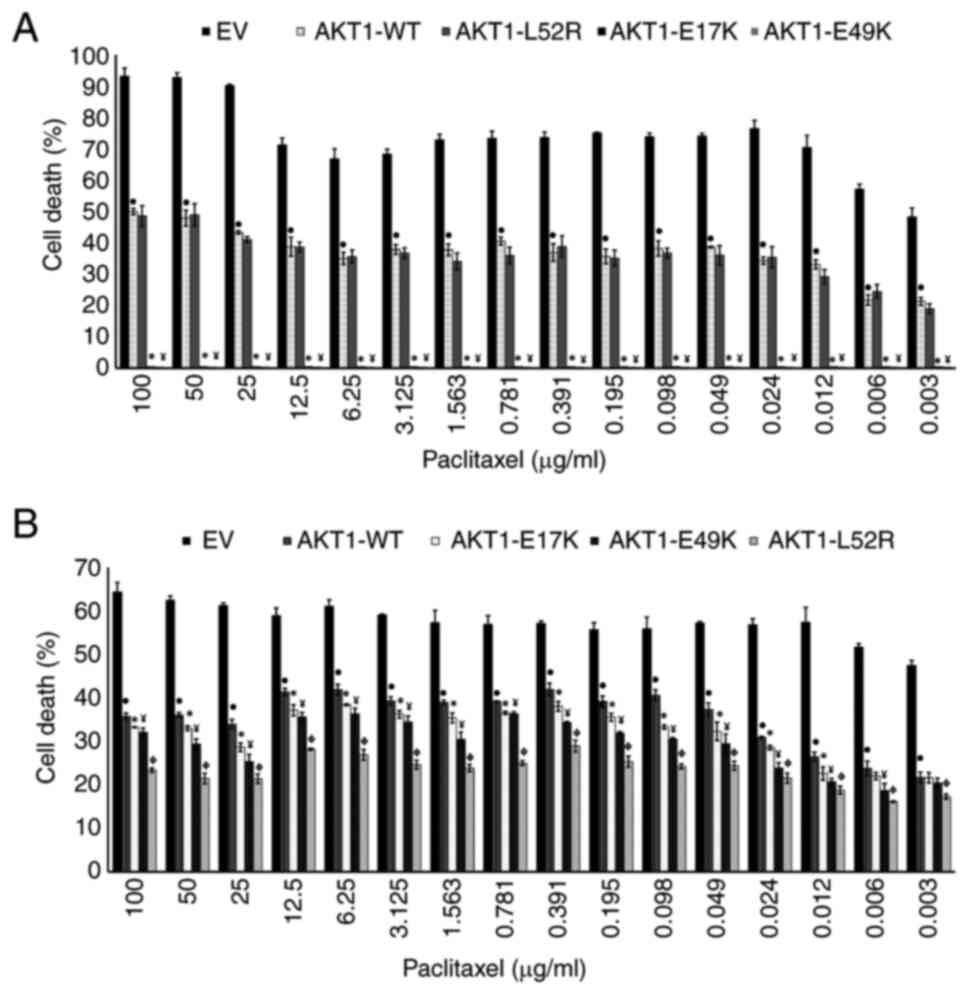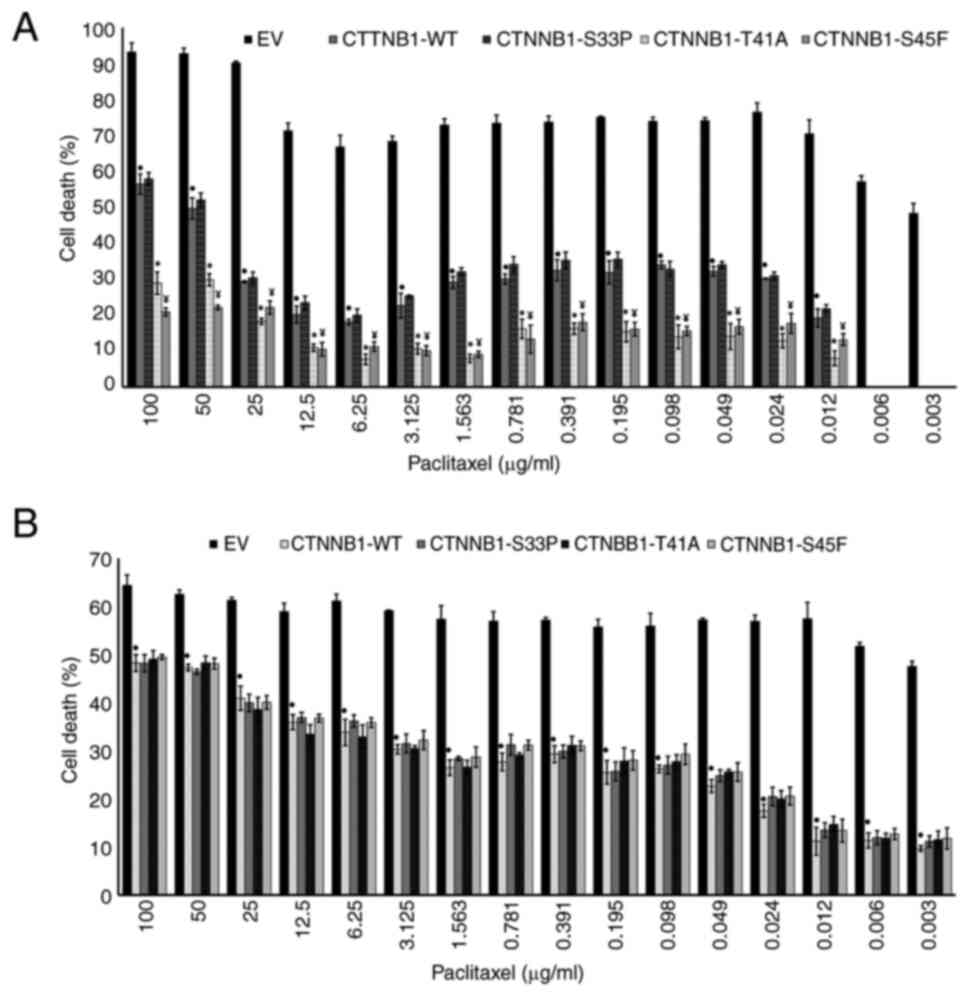|
1
|
Bray F, Laversanne M, Sung H, Ferlay J,
Siegel RL, Soerjomataram I and Jemal A: Global cancer statistics
2022: GLOBOCAN estimates of incidence and mortality worldwide for
36 cancers in 185 countries. CA Cancer J Clin. 74:229–263. 2024.
View Article : Google Scholar : PubMed/NCBI
|
|
2
|
Arnold M, Morgan E, Rumgay H, Mafra A,
Singh D, Laversanne M, Vignat J, Gralow JR, Cardoso F, Siesling S
and Soerjomataram I: Current and future burden of breast cancer:
Global statistics for 2020 and 2040. Breast. 66:15–23. 2022.
View Article : Google Scholar : PubMed/NCBI
|
|
3
|
Turashvili G and Brogi E: Tumor
heterogeneity in breast cancer. Front Med (Lausanne). 4:2272017.
View Article : Google Scholar : PubMed/NCBI
|
|
4
|
Tang Y, Wang Y, Kiani MF and Wang B:
Classification, treatment strategy, and associated drug resistance
in breast cancer. Clin Breast Cancer. 16:335–343. 2016. View Article : Google Scholar : PubMed/NCBI
|
|
5
|
Shi X, Wang J, Lei Y, Cong C, Tan D and
Zhou X: Research progress on the PI3K/AKT signaling pathway in
gynecological cancer. Mol Med Rep. 19:4529–4535. 2019.PubMed/NCBI
|
|
6
|
Noorolyai S, Shajari N, Baghbani E,
Sadreddini S and Baradaran B: The relation between PI3K/AKT
signaling pathway and cancer. Gene. 698:120–128. 2019. View Article : Google Scholar : PubMed/NCBI
|
|
7
|
Dong C, Wu J, Chen Y, Nie J and Chen C:
Activation of PI3K/AKT/mTOR pathway causes drug resistance in
breast cancer. Front Pharmacol. 12:6286902021. View Article : Google Scholar : PubMed/NCBI
|
|
8
|
Cidado J and Park BH: Targeting the
PI3K/Akt/mTOR pathway for breast cancer therapy. J Mammary Gland
Biol Neoplasia. 17:205–216. 2012. View Article : Google Scholar : PubMed/NCBI
|
|
9
|
Nicholson KM and Anderson NG: The protein
kinase B/Akt signaling pathway in human malignancy. Cell Signal.
14:381–395. 2002. View Article : Google Scholar : PubMed/NCBI
|
|
10
|
Basu A and Lambring CB: Akt isoforms: A
family affair in breast cancer. Cancers. 13:34452021. View Article : Google Scholar : PubMed/NCBI
|
|
11
|
Carpten JD, Faber AL, Horn C, Donoho GP,
Briggs SL, Robbins CM, Hostetter G, Bpguslawski S, Moses TY, Savage
S, et al: A transforming mutation in the plekstrin homology domain
of AKT1 in cancer. Nature. 448:439–444. 2007. View Article : Google Scholar : PubMed/NCBI
|
|
12
|
Askham JM, Platt F, Chambers PA, Snowden
H, Taylor CF and Knowles MA: AKT1 mutations in bladder cancer:
Identification of a novel oncogenic mutation that can co-operate
with E17K. Oncogene. 29:150–155. 2010. View Article : Google Scholar : PubMed/NCBI
|
|
13
|
Parikh C, Janakiraman V, Wu WI, Foo CK,
Kljavin NM, Chaudhuri S, Stawiski E, Lee B, Lin J, Li H, et al:
Disruption of PH-kinase domain interactions leads to oncogenic
activation of AKT in human cancers. Proc Natl Acad Sci USA.
109:19368–19373. 2012. View Article : Google Scholar : PubMed/NCBI
|
|
14
|
Hinz N and Jücker M: Distinct functions of
AKT isoforms in breast cancer: A comprehensive review. Cell Commun
Signal. 17:1–29. 2019. View Article : Google Scholar : PubMed/NCBI
|
|
15
|
Jung SH, Kim MS, Lee SH, Park HC, Choi HJ,
Maeng L, Min KO, Kim J, Park TI, Shin OR, et al: Whole-exome
sequencing identifies recurrent AKT1 mutations in sclerosing
hemangioma of lung. Proc Natl Acad Sci USA. 113:10672–10677. 2016.
View Article : Google Scholar : PubMed/NCBI
|
|
16
|
MacDonald BT, Tamai K and He X:
Wnt/β-catenin signaling: Components, mechanisms, and diseases. Dev
Cell. 17:9–26. 2009. View Article : Google Scholar : PubMed/NCBI
|
|
17
|
Xu X, Zhang M, Xu F and Jiang S: Wnt
signaling in breast cancer: Biological mechanisms, challenges and
opportunities. Mol Cancer. 19:1652020. View Article : Google Scholar : PubMed/NCBI
|
|
18
|
Clevers H: Wnt/β-catenin signaling in
development and disease. Cell. 127:469–480. 2006. View Article : Google Scholar : PubMed/NCBI
|
|
19
|
Kimelman D and Xu W: β-Catenin destruction
complex: Insights and questions from a structural perspective.
Oncogene. 25:7482–7491. 2006. View Article : Google Scholar : PubMed/NCBI
|
|
20
|
Liu J, Xiao Q, Xiao J, Niu C, Li Y, Zhang
X, Zhou Z, Shu G and Yin G: Wnt/β-catenin signaling: Function,
biological mechanisms, and therapeutic opportunities. Signal
Transduc Target Ther. 7:32022. View Article : Google Scholar
|
|
21
|
Gao C, Wang Y, Broaddus R, Sun L, Xue F
and Zhang W: Exon 3 mutations of CTNNB1 drive tumorigenesis: A
review. Oncotarget. 9:5492–5508. 2018. View Article : Google Scholar : PubMed/NCBI
|
|
22
|
Van Nhieu JT, Renard CA, Wei Y, Cherqui D,
Zafrani ES and Buendia MA: Nuclear accumulation of mutated
β-catenin in hepatocellular carcinoma is associated with increased
cell proliferation. Am J Pathol. 155:703–710. 1999. View Article : Google Scholar
|
|
23
|
Tanaka Y, Kato K, Notohara K, Hojo H,
Ijiri R, Miyake T, Nagahara N, Sasaki F, Kitagawa N, Nakatani Y and
Kobayashi Y: Frequent β-catenin mutation and cytoplasmic/nuclear
accumulation in pancreatic solid-pseudo papillary neoplasm. Cancer
Res. 61:8401–8404. 2001.PubMed/NCBI
|
|
24
|
Machin P, Catasus L, Pons C, Muñoz J,
Matias-Guiu X and Prat J: CTNNB1 mutations and β-catenin expression
in endometrial carcinomas. Hum Pathol. 33:206–212. 2002. View Article : Google Scholar : PubMed/NCBI
|
|
25
|
Lévy L, Neuveut C, Renard CA, Charneau P,
Branchereau S, Gauthier F, Nhieu JTV, Cherqui D, Petit-Bertron AF,
Mathieu D and Buendia MA: Transcriptional activation of
interleukin-8 by β-catenin-Tcf4. J Biol Chem. 277:42386–42393.
2002. View Article : Google Scholar : PubMed/NCBI
|
|
26
|
Austinat M, Dunsch R, Wittekind C,
Tannapfel A, Gebhardt R and Gaunitz F: Correlation between
β-catenin mutations and expression of Wnt-signaling target genes in
hepatocellular carcinoma. Mol Cancer. 7:21–30. 2008. View Article : Google Scholar : PubMed/NCBI
|
|
27
|
Hamada S, Futamura N, Ikuta K, Urakawa H,
Kozawa E, Ishiguro N and Nishida Y: CTNNB1 S45F mutation predicts
poor efficacy of meloxicam treatment for desmoid tumors: A pilot
study. PLoS One. 9:e963912014. View Article : Google Scholar : PubMed/NCBI
|
|
28
|
An J, Woo HY, Lee Y, Kim HS, Jeong J and
Kim SK: Clinicopathological features of 70 desmoid-type
fibromatoses confirmed by β-catenin immunohistochemical staining
and CTNNB1 mutation analysis. PLoS One. 16:e02506192021. View Article : Google Scholar : PubMed/NCBI
|
|
29
|
Oulès B, Mourah S, Baroudjian B, Jouenne
F, Delyon J, Louveau B, Gruber A, Lebbe C and Battistella M:
Clinicopathologic and molecular characterization of melanomas
mutated for CTNNB1 and MAPK. Virchows Arch. 480:475–480. 2022.
View Article : Google Scholar : PubMed/NCBI
|
|
30
|
Norkowski E, Masliah-Planchon J, Le
Guellec S, Trassard M, Courrèges JB, Charron-Barra C, Terrier P,
Bonvalot S, Coindre JM and Laé M: Lower rate of CTNNB1 mutations
and higher rate of APC mutations in desmoid fibromatosis of the
breast: A series of 134 tumors. Am J Surg Pathol. 44:1266–1273.
2020. View Article : Google Scholar : PubMed/NCBI
|
|
31
|
Li G, Xu D, Sun J, Zhao S and Zheng D:
Paclitaxel inhibits proliferation and invasion and promotes
apoptosis of breast cancer cells by blocking activation of the
PI3K/AKT signaling pathway. Adv Clin Exp Med. 29:1337–1345. 2020.
View Article : Google Scholar : PubMed/NCBI
|
|
32
|
Zhao S, Tang Y, Wang R and Najafi M:
Mechanisms of cancer cell death induction by paclitaxel: An updated
review. Apoptosis. 27:647–667. 2022. View Article : Google Scholar : PubMed/NCBI
|
|
33
|
Alalawy AI: Key genes and molecular
mechanisms related to Paclitaxel Resistance. Cancer Cell Int.
24:2442024. View Article : Google Scholar : PubMed/NCBI
|
|
34
|
Froger A and Hall JE: Transformation of
plasmid DNA into E. coli using the heat shock method. J Vis Exp.
2532007.doi: 10.3791/253. PubMed/NCBI
|
|
35
|
Ke X and Shen L: Molecular targeted
therapy of cancer: The progress and future prospect. Front Med.
1:69–75. 2017.
|
|
36
|
Tarighati E, Keivan H and Mahani H: A
review of prognostic and predictive biomarkers in breast cancer.
Clin Exp Med. 23:1–16. 2023.PubMed/NCBI
|
|
37
|
Duffy MJ and Crown J: A personalized
approach to cancer treatment: How biomarkers can help. Clin Chem.
54:1770–1779. 2008. View Article : Google Scholar : PubMed/NCBI
|
|
38
|
Beaver JA, Gustin JP, Yi KH, Rajpurohit A,
Thomas M, Gilbert SF, Rosen DM, Park BH and Lauring J: PIK3CA and
AKT1 mutations have distinct effects on sensitivity to targeted
pathway inhibitors in an isogenic luminal breast cancer model
system. Clin Cancer Res. 19:5413–5422. 2013. View Article : Google Scholar : PubMed/NCBI
|
|
39
|
Welsh J: Animal models for studying
prevention and treatment of breast cancer. Animal Models for the
Study of Human Disease. Conn PM: Academic Press; Cambridge: pp.
997–1018. 2013, View Article : Google Scholar
|
|
40
|
Waks AG and Winer EP: Breast cancer
treatment: A review. JAMA. 321:288–300. 2019. View Article : Google Scholar : PubMed/NCBI
|
|
41
|
Burguin A, Diorio C and Durocher F: Breast
cancer treatments: Updates and new challenges. J Pers Med.
11:8082021. View Article : Google Scholar : PubMed/NCBI
|
|
42
|
Kaboli PJ, Imani S, Jomhori M and Ling KH:
Chemoresistance in breast cancer: PI3K/Akt pathway inhibitors vs
the current chemotherapy. Am J Cancer Res. 11:51552021.PubMed/NCBI
|
|
43
|
Kim MS, Jeong EG, Yoo NJ and Lee SH:
Mutational analysis of oncogenic AKT E17K mutation in common solid
cancers and acute leukaemias. Br J Cancer. 98:1533–1535. 2008.
View Article : Google Scholar : PubMed/NCBI
|
|
44
|
Lauring J, Park BH and Wolff AC: The
phosphoinositide-3-kinase-Akt mTOR pathway as a therapeutic target
in breast cancer. J Natl Compre Cancer Netw. 11:670–678. 2013.
View Article : Google Scholar : PubMed/NCBI
|
|
45
|
Guo G, Qiu X, Wang S, Chen Y, Rothman PB,
Wang Z and Chen JL: Oncogenic E17K mutation in the plekstrin
homology domain of AKT1 promotes v-Abl-mediated pre-B-cell
transformation and survival of Pim-deficient cells. Oncogene.
29:3845–3853. 2010. View Article : Google Scholar : PubMed/NCBI
|
|
46
|
Yang WL, Zhang X and Lin HK: Emerging role
of Lys-63 ubiquitination in protein kinase and phosphatase
activation and cancer development. Oncogene. 29:4493–4503. 2010.
View Article : Google Scholar : PubMed/NCBI
|
|
47
|
Yi KH, Axtmayer J, Gustin JP, Rajpurohit A
and Lauring J: Functional analysis of non-hotspot AKT1 mutants
found in human breast cancers identifies novel driver mutations:
Implications for personalized medicine. Oncotarget. 4:29–34. 2013.
View Article : Google Scholar : PubMed/NCBI
|
|
48
|
De Marco C, Malanga D, Rinaldo N, De Vita
F, Scrima M, Lovisa S, Fabris L, Carriero MV, Franco R, Rizzuto A,
et al: Mutant AKT1-E17K is oncogenic in lung epithelial cells.
Oncotarget. 6:39634–39650. 2015. View Article : Google Scholar : PubMed/NCBI
|
|
49
|
Hasbal-Celikok G, Aksoy-Sagirli P,
Altiparmak-Ulbegi G and Can A: Identification of AKT1/β-catenin
mutations conferring cetuximab and chemotherapeutic drug resistance
in colorectal cancer treatment. Oncol Lett. 21:1–10. 2021.
View Article : Google Scholar : PubMed/NCBI
|
|
50
|
Davies BR, Guan N, Logie A, Crafter C,
Hanson L, Jacobs V, James N, Dudley P, Jacques K, Ladd B, et al:
Tumors with AKT1 E17K mutations are rational targets for single
agent or combination therapy with AKT inhibitors. Mol Can Ther.
14:2441–2451. 2015. View Article : Google Scholar : PubMed/NCBI
|
|
51
|
Hyman DM, Smyth LM, Donoghue MTA, Westin
SN, Bedard PL, Dean EJ, Bando H, El–Khoueiry AB, Pérez–Fidalgo JA,
Mita A, et al: AKT inhibition in solid tumors with AKT1 mutations.
J Clin Oncol. 35:2251–2259. 2017. View Article : Google Scholar : PubMed/NCBI
|
|
52
|
Schmid P, Abraham J, Chan S, Wheatley D,
Brunt AM, Nemsadze G, Baird RD, Park YH, Hall PS, Perren T, et al:
Capivasertib plus paclitaxel versus placebo plus paclitaxel as
first-line therapy for metastatic triple-negative breast cancer:
The PAKT trial. J Clin Oncol. 38:423–433. 2020. View Article : Google Scholar : PubMed/NCBI
|
|
53
|
Smyth LM, Tamura K, Oliveira M, Ciruelos
EM, Mayer IA, Sablin MP, Biganzoli L, Ambrose HJ, Ashton J,
Barnicle A, et al: Capivasertib, an AKT kinase inhibitor, as
monotherapy or in combination with fulvestrant in patients with
AKT1 E17K-Mutant, ER-positive metastatic breast cancer. Clin Cancer
Res. 26:3947–3957. 2020. View Article : Google Scholar : PubMed/NCBI
|
|
54
|
Lin SY, Xia W, Wang JC, Kwong KY, Spohn B,
Wen Y, Pestell RG and Hung MC: Beta-catenin, a novel prognostic
marker for breast cancer: Its roles in cyclin D1 expression and
cancer progression. Proc Natl Acad Sci USA. 97:4262–4266. 2000.
View Article : Google Scholar : PubMed/NCBI
|
|
55
|
Ryo A, Nakamura M, Wulf G, Liou YC and Lu
KP: Pin1 regulates turnover and subcellular localization of
beta-catenin by inhibiting its interaction with APC. Nat Cell Biol.
3:793–801. 2001. View Article : Google Scholar : PubMed/NCBI
|
|
56
|
Li S, Li S, Sun Y and Li L: The expression
of β-catenin in different subtypes of breast cancer and its
clinical significance. Tumor Biol. 35:7693–7698. 2014. View Article : Google Scholar
|
|
57
|
Samant C, Kale R, Pai KSR, Nandakumar K
and Bhonde M: Role of Wnt/β-catenin pathway in cancer drug
resistance: Insights into molecular aspects of major solid tumors.
Biochem Biophys Res Commun. 729:1503482024. View Article : Google Scholar : PubMed/NCBI
|
|
58
|
Mukherjee N and Panda CK: Wnt/β-catenin
signaling pathway as chemotherapeutic target in breast cancer: An
update on pros and cons. Clin Breast Cancer. 20:361–370. 2020.
View Article : Google Scholar : PubMed/NCBI
|
|
59
|
Ozcan G: PTCH1 and CTNNB1 emerge as
pivotal predictors of resistance to neoadjuvant chemotherapy in
ER+/HER2-breast cancer. Front Oncol. 13:12164382023. View Article : Google Scholar : PubMed/NCBI
|
|
60
|
Yoo TK, Lee WS, Kim J, Kim MK, Park IA,
Kim JH and Han W: Mutational analysis of triple-negative breast
cancer using targeted kinome sequencing. J Breast Cancer.
25:1642022. View Article : Google Scholar : PubMed/NCBI
|
|
61
|
Geyer FC, Lacroix-Triki M, Savage K,
Arnedos M, Lambros MB, MacKay A, Natrajan R and Reis-Filho JS:
β-catenin pathway activation in breast cancer is associated with
triple-negative phenotype but not with CTNNB1 mutation. Mod Pathol.
24:209–231. 2011. View Article : Google Scholar : PubMed/NCBI
|

















